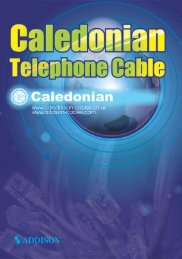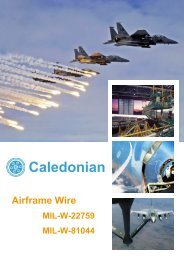caledonian Rolling Stock Cables
EN 50264 | EN 50306 | EN 50382 | Databus RS 485 | RSE/STD/024 PART 6
EN 50264 | EN 50306 | EN 50382 | Databus RS 485 | RSE/STD/024 PART 6
You also want an ePaper? Increase the reach of your titles
YUMPU automatically turns print PDFs into web optimized ePapers that Google loves.
Caledonian<br />
The required toxicity indices for cables and wires, depending on hazard level, in accordance with EN 50264 are<br />
displayed in the following table:<br />
HL<br />
HL 1<br />
HL 2 / HL 3<br />
HL 4<br />
ITC<br />
not specified<br />
5 (Max.)<br />
3 (Max.)<br />
The required toxicity indices for cables and wires, depending on hazard level, in accordance with EN 50306 (thin<br />
wall) are displayed in the following table:<br />
HL<br />
ITC<br />
Insulation and Sheath S1<br />
EM101-104 and Sheath S2<br />
HL 1 not stipulated not stipulated<br />
HL 2 / HL 3 10 (Max.) 5 (Max.)<br />
HL 4 6 (Max.) 3 (Max.)<br />
Toxic Fumes:<br />
Naval standard NES713 burns a set amount of material and analyses the gases given off. The volume of each gas is<br />
multiplied by the toxicity index for each gas. The toxicity index for each gas are added together to give an overall toxicity<br />
index for the material. LFH materials should have a toxicity index max.of 10.<br />
Flame Retardance:<br />
In accordance with EN 50265- 2-1 or IEC 60332-1, testing is carried out for a single insulated wire or cable. The specimen<br />
is deemed to have passed this test, if after burning has ceased, the charred or affected position does not reach within<br />
50mm of the lower edge of the top clamp.<br />
In accordance EN 50266-2-4, EN 50305 9.1 and IEC 60332-3, testing is carried out for bunched cables. A gas burner<br />
flame is applied to the bottom of a vertically arranged conductor bundle in a test furnace. Following completion of the flame<br />
test, the specimen consisting of 3.5m, is deemed to have met the requirements, if after burning has ceased, the extent of<br />
charred or affected portion does not reach a height exceeding 2.5m above the bottom edge of the burner.<br />
Smoke Density:<br />
For smoke density testing, the cube test is employed according to EN 50268-2-1 or IEC 61034. The 3 metre cube test<br />
measures the generation of smoke from electric cables during fire. A light beam emitted from a window is projected across<br />
the enclosure of a photo cell connected to a recorder at the opposite window.<br />
The recorder is adjusted to register from 0 % for complete obscuration to 100 % luminous transmission. A 1 metre cable<br />
sample is placed in the centre of the enclosure and then subjected to fire. The minimum light transmission of the smoke is<br />
then measured.<br />
The following table shows the minimum percentages of light transmission depending on hazard level:<br />
HL<br />
Light Transmission<br />
HL 1<br />
not specified<br />
HL 2 / HL 3 60 %<br />
HL 4 70 %<br />
BS 6853<br />
In 1999 BS 6853 was introduced in UK and whose highest categories are probably the most demanding in the world. BS<br />
6853 covers both smoke emission testing and flammability testing. BS 6853 also introduced the concept of an R-Index,<br />
which is a single number quantification of the toxic gas risk associated with composite materials for use in railway rolling<br />
stock. The R-Indices are split into the following categories:<br />
Category 1a Trains which predominantly use tunnels R < 1.0<br />
Category 1b Trains which use tunnels, but infrequently R < 1.6<br />
Category 2 Trains which run, predominantly, overground R < 3.6<br />
The R-Index is generated by analysing eight gases of combustion, for which critical concentrations have been established<br />
by NIOSH/OSHA and reported as IDLH (Immediately Dangerous to Life and Health) values.<br />
Toxicity is the most important factor to address during the cable design. Toxicity limit for the UK and France are identical<br />
because both require the same test method for elastomers (NF X 70-100). The only difference is that the U.K.'s<br />
specification requires an addendum for nitrous oxides. Toxicity limits for French and the U.K. standards are developed from<br />
the IDLH values published in the National Institute for Occupational Safety and Health (NIOSH) Guide. IDLH (Immediately<br />
Dangerous to Life or Health) values are calculated based on levels of gas in a particular atmosphere for 30 minutes that<br />
would pose an immediate risk U.K.'s BS 6853 specification is the most stringent, closely followed by the French, and finally<br />
the Germany introduced the toxicity test in 2009.<br />
8








